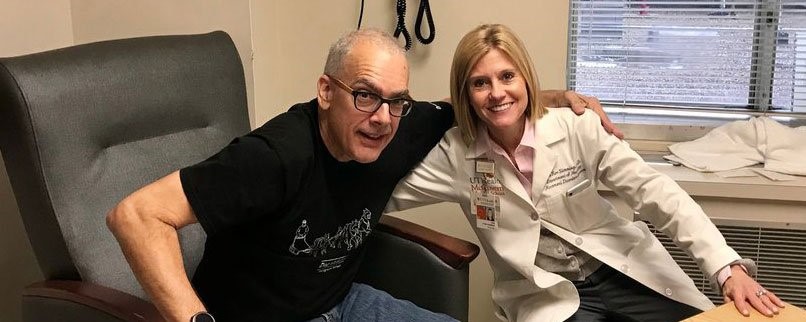Jon Huffman: Making a Difference by Participating in Huntington’s Disease Research

Three generations of Jon Huffman’s family have suffered Huntington’s disease – a rare, inherited, ultimately fatal disease that causes the progressive breakdown of nerve cells in the brain and is best known for the associated involuntary movements, as well as cognitive and psychiatric symptoms.
So it didn’t come as a particular surprise to Jon or Patricia Huffman, his wife of 36 years, when Jon began showing symptoms of the neurodegenerative disorder around 2007.
“When Jon was driving, he’d have a heavy foot that would brake often,” Patricia said. “He would also lose control of his hands and become irritable.”
However, it wasn’t until the couple’s two college-aged sons started developing romantic relationships that Jon and Patricia, who had known about Jon’s family history with Huntington’s disease since they started dating in college, grew more concerned about younger generations inheriting the disease and decided to get Jon tested. In 2014, Jon was officially diagnosed with Huntington’s disease.
As retired pharmacists, the Huffmans were curious about recent scientific advancements in the field, and Jon signed up for a clinical trial at one local institution, testing the effectiveness of a drug in improving Huntington’s disease symptoms. Ultimately, the trial proved unsuccessful, but that didn’t stop Jon from wanting to participate in others.
“I’ve never feared testing,” Jon said. “It feels like you make a difference.”
He made his way to UTHealth Houston in 2018 to participate in several trials led locally by Erin Furr Stimming, MD, director of the Huntington’s Disease Society of America (HDSA) Center of Excellence at UTHealth Houston Neurosciences and professor of neurology with McGovern Medical School at UTHealth Houston.
“We are proud to have a HDSA Level 1 Center of Excellence designation, which means we provide multidisciplinary Huntington’s disease-specific care not only in Houston but in other Texas cities such as Lubbock, San Antonio, Austin, and Waco, in collaboration with out partnering sites. Our goal is to expand Huntington’s disease care and awareness throughout the state of Texas,” Furr Stimming said. “We are honored to be a site for multiple clinical trials as a result of our robust Huntington’s disease clinic. While research is absolutely independent of clinical care, it’s important that our patients and their families have the opportunity to participate in research, if and when they express interest and qualify.”
Over the past few years, Jon enrolled in multiple studies at the center, including Enroll-HD – a worldwide observational study that includes more than 20,000 participants in four continents. Jon’s information was entered into a dataset that is being used to analyze various outcomes in individuals living with or at risk for Huntington’s disease.
Jon also participated in an observational study assessing olfactory function, or sense of smell, in people with Huntington’s disease. Patricia even joined the control group for the study.
“With our scientific backgrounds, we understand that science is discovery, and scientists are still learning so much information about this disease,” Patricia said. “There’s no cure yet, but we hope there’s enough discovery going on that there will be something in the future.”
So far, the research has already led to several breakthroughs. For instance, in retrospectively analyzing the Enroll-HD dataset, Furr Stimming and her team at UTHealth Houston have determined that there are in fact sex differences in Huntington’s disease, with women appearing to have worse symptoms than men. In addition, from the Enroll-HD data, they have published on the incidence of psychosis, depression, and suicidality in the disease.
Furr Stimming said discoveries like these will ultimately help health care providers offer better treatment options for patients with the disease while parallel, interventional studies are performed to test various therapeutic strategies in an attempt to slow or halt disease progression.
“Jon and Patricia are an inspirational couple,” Furr Stimming says. “They are the perfect example of what we see in families with Huntington’s disease in that they are incredibly resilient, and they’re doing all they can on their end. It is a privilege to work with them and our other Huntington’s patients and their families.”
The couple – whose now-adult sons both tested negative for the disease and therefore will not pass it onto their children – is deeply involved with the local, regional, and national Huntington’s disease communities. They have advocated for the HD Parity Act, which would waive the two-year Medicare waiting period as well as waive the five-month benefit waiting period for individuals with the disease.
Jon and Patricia also stay active, taking dance lessons at a dance studio in Katy. They recently competed in a regional dance event, dedicating their performance to Marjorie Guthrie, the late wife of music legend Woody Guthrie, who was instrumental in raising awareness for Huntington’s disease.
When he isn’t dancing with his wife, Jon likes to walk his dog around the neighborhood every day. “I have slurred speech, so when I walk my dog, people will ask if I’m OK. Yes, I am OK,” Jon said. “You should never fear Huntington’s disease.”











